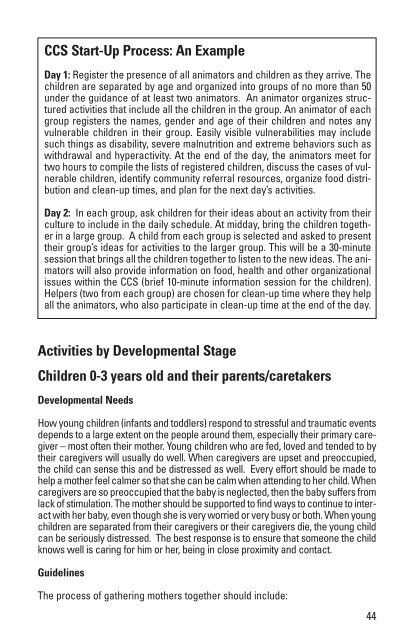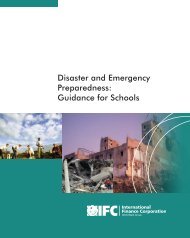Starting Up Child Centered Spaces in Emergencies: A Field Manual
Starting Up Child Centered Spaces in Emergencies: A Field Manual
Starting Up Child Centered Spaces in Emergencies: A Field Manual
- No tags were found...
You also want an ePaper? Increase the reach of your titles
YUMPU automatically turns print PDFs into web optimized ePapers that Google loves.
CCS Start-<strong>Up</strong> Process: An ExampleDay 1: Register the presence of all animators and children as they arrive. Thechildren are separated by age and organized <strong>in</strong>to groups of no more than 50under the guidance of at least two animators. An animator organizes structuredactivities that <strong>in</strong>clude all the children <strong>in</strong> the group. An animator of eachgroup registers the names, gender and age of their children and notes anyvulnerable children <strong>in</strong> their group. Easily visible vulnerabilities may <strong>in</strong>cludesuch th<strong>in</strong>gs as disability, severe malnutrition and extreme behaviors such aswithdrawal and hyperactivity. At the end of the day, the animators meet fortwo hours to compile the lists of registered children, discuss the cases of vulnerablechildren, identify community referral resources, organize food distributionand clean-up times, and plan for the next day’s activities.Day 2: In each group, ask children for their ideas about an activity from theirculture to <strong>in</strong>clude <strong>in</strong> the daily schedule. At midday, br<strong>in</strong>g the children together<strong>in</strong> a large group. A child from each group is selected and asked to presenttheir group’s ideas for activities to the larger group. This will be a 30-m<strong>in</strong>utesession that br<strong>in</strong>gs all the children together to listen to the new ideas. The animatorswill also provide <strong>in</strong>formation on food, health and other organizationalissues with<strong>in</strong> the CCS (brief 10-m<strong>in</strong>ute <strong>in</strong>formation session for the children).Helpers (two from each group) are chosen for clean-up time where they helpall the animators, who also participate <strong>in</strong> clean-up time at the end of the day.Activities by Developmental Stage<strong>Child</strong>ren 0-3 years old and their parents/caretakersDevelopmental NeedsHow young children (<strong>in</strong>fants and toddlers) respond to stressful and traumatic eventsdepends to a large extent on the people around them, especially their primary caregiver– most often their mother. Young children who are fed, loved and tended to bytheir caregivers will usually do well. When caregivers are upset and preoccupied,the child can sense this and be distressed as well. Every effort should be made tohelp a mother feel calmer so that she can be calm when attend<strong>in</strong>g to her child. Whencaregivers are so preoccupied that the baby is neglected, then the baby suffers fromlack of stimulation. The mother should be supported to f<strong>in</strong>d ways to cont<strong>in</strong>ue to <strong>in</strong>teractwith her baby, even though she is very worried or very busy or both. When youngchildren are separated from their caregivers or their caregivers die, the young childcan be seriously distressed. The best response is to ensure that someone the childknows well is car<strong>in</strong>g for him or her, be<strong>in</strong>g <strong>in</strong> close proximity and contact.Guidel<strong>in</strong>esThe process of gather<strong>in</strong>g mothers together should <strong>in</strong>clude:44
















